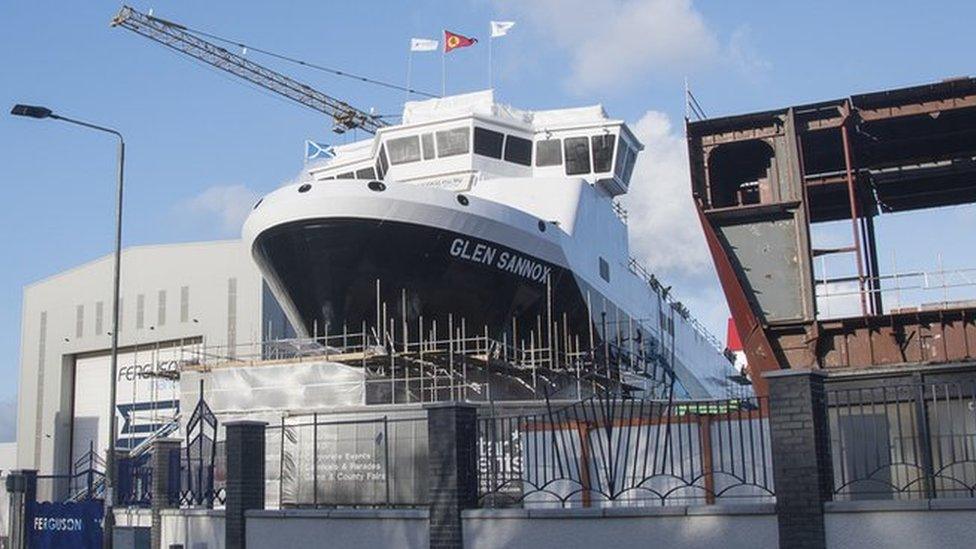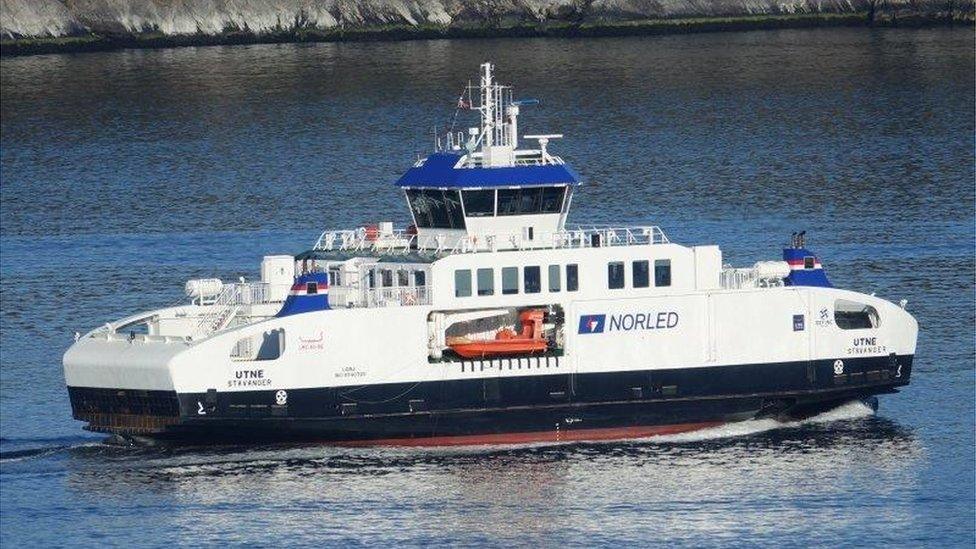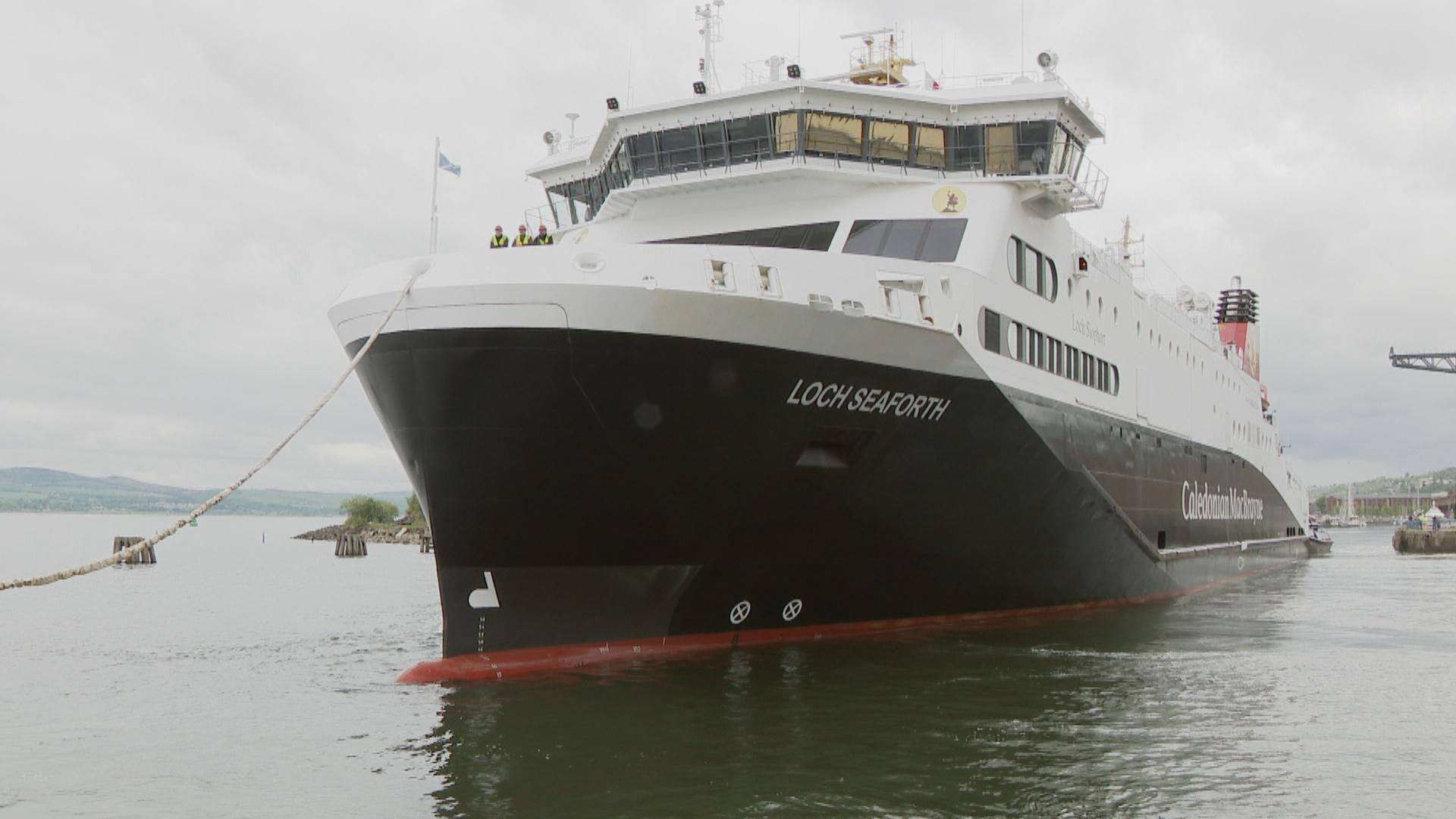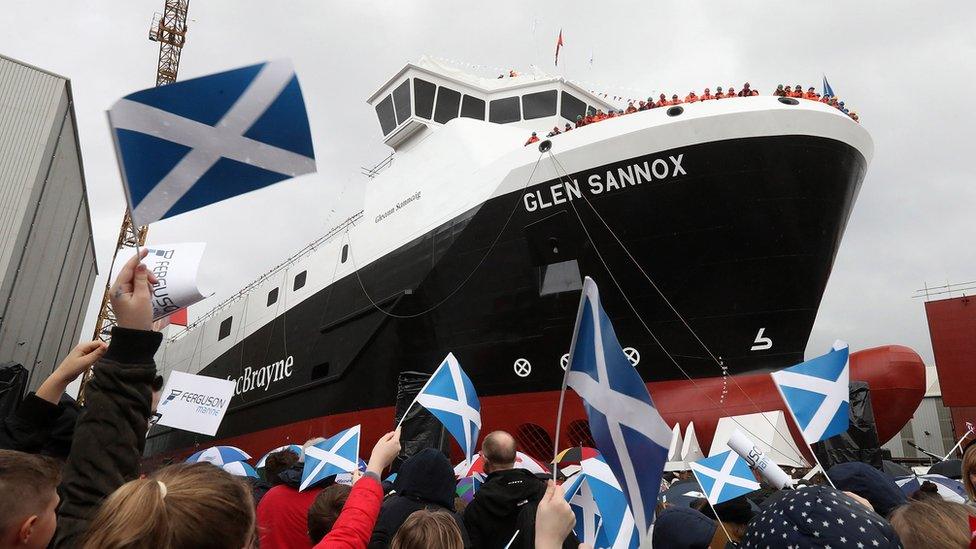Frustration as island ferry struggles with demand
- Published

In a year of staycations the crossing to Mull has proved especially popular, putting huge pressure on a ferry service already struggling to cope with demand.
That is made worse when a ship is taken out of service as happened on the day I visited the island.
One of the two ferries that serve the popular route from Oban to Craignure, the main port on the island, was tied up while engineers worked to fix the propulsion system.
Some of the MV Coruisk's sailings had been cancelled and the backlog of traffic and the frustration of some stranded passengers was building.
"I'm not having the best of days," said Peter Lees - a visitor to Mull who was trying to get off the island with his car and caravan.

Peter Lees was having trouble getting off the island with his car and caravan
"CalMac are not my favourite people right now," he said.
"I'll just have to wait until they can fit me in," Mr Lees said, joking that this was "Scottish tourism at its finest".
While Mr Lees was facing a one-off delay to his journey home, ferry problems are a way of life for those who live and work on the islands.
"It's the sort of drip, drip of inconvenience all the time rather than major calamities," said Joe Reade, who runs the Island Bakery in Tobermory.

Joe Reade talks of a "drip, drip of inconvenience"
Mr Reade, who also chairs the local ferry users' committee, said: "If you're going away you have to go a day early because the ferry timetable is so restricted.
"When you come back you get stuck off the island. It just adds cost, it adds time and it affects the quality of life in a big way."
For Mull, the biggest problem is capacity. The island is so popular with visitors, the ferry service is struggling to cope with growing demand.
That means islanders cannot always get a space on the ferry when they need one.
Mr Reade tells me that caused a particular problem in the summer when mourners could not make the crossing in time to attend a funeral.
Fully-booked ferries are also a challenge for island farmers trying to get livestock to market on the mainland.

Claire Simonetta says major service improvements are required
Tending sheep and Highland cattle at Torloisk farm, Claire Simonetta said local CalMac staff were "fantastic" but that major service improvements are required.
"There's only so much the ground staff can do," she said. "We need a modern fleet, a more reliable fleet, a fleet that's built to deal with the challenges that we have now."
So what are these challenges?
CalMac accepts that its "major challenge" is capacity, especially on popular routes like Mull and Arran.
It is carrying more vehicles and passengers than ever by making the existing fleet work harder and using crews to their maximum working hours.

CalMac's managing director Robbie Drummond says he is sorry for the disruption this year
According to CalMac's managing director, Robbie Drummond, that means "there's just no space in the service for any disruption".
But there's always disruption in ferry services and during the pandemic that has been unprecedented.
Covid gets the blame for many of this year's cancellations, with vessels taken out of service when there are cases onboard.

The MV Coruisk was out of service at Craignure.
Then there are technical issues, like the problems on the MV Coruisk at Craignure.
That was one of more than 100 faults to hit the fleet so far this year.
While some breakdowns are relatively minor and lead to few cancellations, others can have a dramatic impact.
Engine problems on the flagship MV Loch Seaforth in the spring took it out of service for nearly seven weeks, causing major disruption.
When a ferry becomes unavailable, others are diverted to help out with knock-on impacts for other islands.
CalMac says fewer than one in 125 sailings are affected by technical problems and that they are relatively "low and manageable".
One experienced CalMac mariner tells me the fleet does not get as much preventative maintenance as it once did.
Speaking on condition of anonymity, the sailor said that was because ships and crews were spending much more time at sea and much less in harbour.
"The people themselves are tired and the boat's tired and they're not getting time to do the preventative maintenance" beyond what's legally required, he said.
Vessels go into dry dock for major overhauls each year but Mr Drummond accepts that fitting in all the resilience work in the winter months when the fleet is less busy is proving difficult.
Bad weather is the principal cause of disruption and some islanders suspect CalMac is becoming more risk averse and calling off sailings on that basis more readily now.
Highest number of cancellations
All of these factors add up to what looks set to be a record-breaking year for service disruption.
CalMac cancelled about one in 19 sailings in the first nine months of 2021.
Those 6,431 cancellations were more than for the whole of 2019 when there were 5,650.
The Scottish government-owned operator is on course for its highest ever annual number of cancellations.
Disruption was at its worst in 2020 when 7,434 sailings were withdrawn from a timetable already much reduced by lockdown.
These figures were released to BBC Scotland by CalMac, updating data they gave to Conservative MSP Edward Mountain under freedom on information.
Mr Mountain, who chaired a Holyrood committee inquiry into ferry procurement problems, says the CalMac fleet is not being replaced quickly enough.
"We should be building two new ferries every year for the next 10 years to get our fleet back into shape," he says.

Tory MSP Edward Mountain said we needed to be replacing ferries
More than half of all CalMac ferries are more than 25 years old and around a third are in their thirties, which Mr Mountain thinks is unacceptable.
"I've never seen the first minister being driven to work in a 30-year-old car, so why should we expect islanders to rely on 30-year-old ferries to do the lifeline services that they're doing?," the Tory MSP says.
Transport Scotland turned down BBC Scotland's request to interview a Scottish government minister about CalMac's problems.
In a statement, they said that while ferry operation and maintenance is CalMac's responsibility, they recognised the frustration caused by disruption.
"We are doing everything that we can to support CalMac to maximise available capacity across the network," they said.
They are promising £580m of investment in the fleet over the next five years including the purchase of new ships.
New ferries are being ordered for Islay and £9m is being spent buying and converting a second-hand ferry, MV Utne, from Norway for Mull.
In addition, the Ferguson shipyard is promising to deliver the scandalously overdue and overbudget ferries MV Glen Sannox and hull 802 next year.
In the meantime, CalMac is likely to remain overstretched.
It expects record levels of demand in 2022 and managing director, Robbie Drummond, said that will be "very challenging" to manage.
"I'm sorry for all the disruption that has happened this year, particularly the disruption around the Loch Seaforth," he said.
"I give an assurance that we will do our absolute best to provide the best service that we can because we really care about it," says Mr Drummond.
CalMac can only work with the ships that it is provided by CMAL, the separate company that owns the fleet and many of the harbours.
Both CalMac and CMAL are answerable to Transport Scotland which is an arm of their owners, the Scottish government.
It is a complicated structure designed to be compatible with EU rules that Mr Drummond concedes has "clearly not worked as well as everyone would like".
Mr Mountain wants an overhaul of these arrangements and an independent inquiry into Hebridean and Clyde ferry service provision.
Whether or not that happens, it seems that it may be several years before the west coast islands can have a more extensive and more reliable ferry service.
Related topics
- Published14 September 2021

- Published5 October 2021

- Published28 May 2021

- Published9 December 2020
